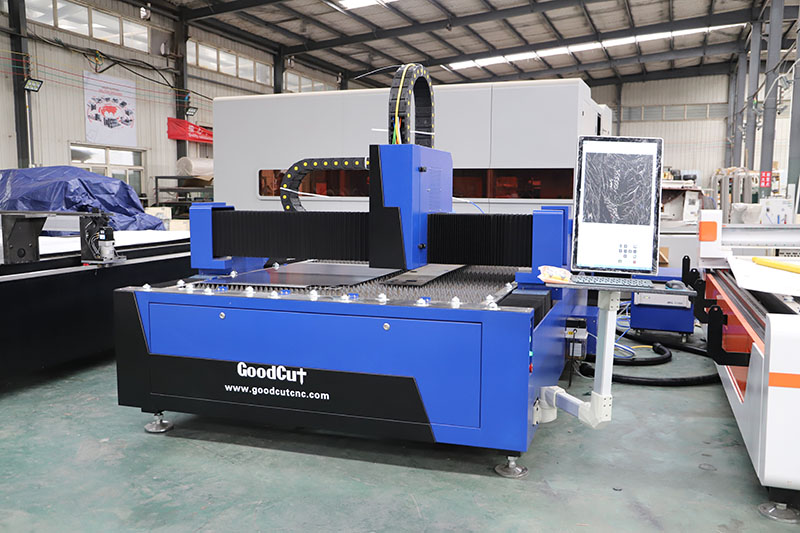
Fiber laser cutting tables are key components for achieving precise and efficient material cutting. These cutting tables also have a significant impact on the results and efficiency of the cutting process. This article takes an in-depth look at the various classifications of fiber laser cutting tables. Their construction, materials, dimensions, and the potential for multi-platform configurations are examined. By understanding these aspects, manufacturers can make informed decisions to meet their operational needs and long-term goals.
1. Structure of Fiber Laser Cutting Tables
The structure of a fiber laser cutting table is fundamental to its functionality and effectiveness. These tables are designed to withstand the demanding environment of laser cutting.
* Frame Construction: The frame of the laser cutting table is typically made from heavy-duty steel, engineered to withstand the vibrations and thermal effects of laser cutting. This robust construction ensures minimal movement during operation, maintaining precision in cuts.
* Table Layout: Most fiber laser tables feature a grid or slat design. This allows debris from the cutting process to fall away from the material, maintaining a clean cutting area and preventing damage to both the laser head and the material being cut.
* Adjustability and Accessibility: High-end models offer adjustable heights and tilting capabilities, which help ergonomics and accessibility for operators. This feature is particularly beneficial in custom fabrication shops where versatility is crucial.
2. Materials Used in Laser Cutting Tables
The material selection for manufacturing a laser cutting table is critical. It directly affects its lifespan, functionality, and suitability for specific types of metal cutting.
* Metal frame: The most common material for laser cutting table frames is structural steel. Frame types are divided into tube-welded frames and plate-welded frames. Plate-welded frames bear more weight and are relatively more durable. But tube welded frames are a more cheap choice.
* Protective coating: To further improve durability, the surface of the cutting table is usually treated or coated with heat resistance and corrosion reduction. These coatings help maintain the integrity of the table surface.
3. Dimensions and Scalability
The size of the fiber laser cutting table is a key factor in determining its suitability for a specific application and adaptability in a variety of industrial environments.
Standard and Custom Sizes: Fiber laser cutting tables are available in a variety of standard sizes. They typically include small tables for precise, small-scale work, as well as large tables that can accommodate large quantities of metal sheets. Custom sizes are also available to meet specific needs, providing a solution for every type of manufacturing process. The most common sizes are 3000mm×1500mm to 6000mm to 2000mm. Other sizes can generally be customized by contacting the manufacturer.
4. Multi-Platform Fiber Laser Tables
Multi-platform fiber laser tables represent the cutting edge in laser cutting technology, offering unparalleled versatility and efficiency.
* Increased productivity: A multi-platform workbench has many workstations. It can carry out many processes at the same time, which significantly increases productivity. For example, when one part of the workbench is used for cutting, another part may be used for assembly or quality inspection.
* Versatility: These tables can support a variety of laser types and configurations. They can be used for a wide range of materials and thicknesses. This versatility is ideal for shops that process many material types or need to quickly switch between different production tasks.
* Integration capabilities: Advanced multi-platform workbenches are usually equipped with advanced software and hardware interfaces. They can be seamlessly integrated with factory automation systems. This integration helps streamline operations and reduce the possibility of human error.
Multi-platform fiber laser tables are an investment in flexibility and productivity. They provide manufacturers with the tools to quickly adapt to market changes and customer needs. By leveraging these advanced systems, companies can maximize their operational capabilities.
5. Choosing the Right Fiber Laser Cutting Table
Selecting the appropriate fiber laser cutting table involves careful consideration of various factors to ensure it meets specific manufacturing needs. Here’s a guideline on how to choose the right table:
* Assess Your Needs: Determine the primary application of your fiber laser cutting table. Consider the types of metals you frequently work with, the range of thicknesses and the typical size of the materials.
* Table Size and Scalability: Choose a table size that not only fits your current needs but also has potential for future expansion. Scalable models offer the flexibility to increase capacity as your business grows.
* Technology and Features: Test the technology and features offered by different tables. Look for advanced capabilities like multi-platform operations and automated controls that can enhance productivity and precision.
* Quality and Durability: Invest in a table that is robust and built to last. High-quality materials and construction will ensure that the table withstands the rigors of continuous operation.
* Support and service: Consider the level of customer support and service provided by the manufacturer. Reliable after-sales service and spare parts supply can reduce downtime.
Contact: Smile Ji
Wechat: 008618396857273
Whatsapp: 008618396857273
Tel: 008618396857273
Email: smileji@goodcutcnc.com
Add: 402 Jinxing Longsheng Building, High-tech district, Jinan City, Shandong Province, China